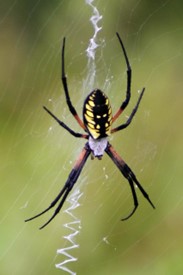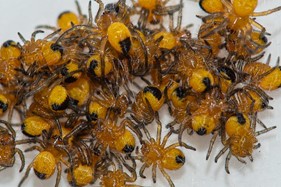The Black and Yellow Garden Spider
As a child, spiders didn’t scare me. In fact, I looked forward to the time that I could own a tarantula of my own.
 There was one exception to this, though, and it was the dreaded garden spider (we called them banana spiders). The thought of unknowingly walking through a web and getting one of those spiders on me was enough to keep me away from gardens and tall grass altogether. What a mistake that was! I now know that most of the things I thought I knew about garden spiders were wrong and that I had no reason to fear them. Let’s go over some of their unique characteristics.
There was one exception to this, though, and it was the dreaded garden spider (we called them banana spiders). The thought of unknowingly walking through a web and getting one of those spiders on me was enough to keep me away from gardens and tall grass altogether. What a mistake that was! I now know that most of the things I thought I knew about garden spiders were wrong and that I had no reason to fear them. Let’s go over some of their unique characteristics.
The black and yellow garden spider (Argiope aurantia) is found throughout the continental United States, Canada, Mexico, and much of Central America. They get their name by having a bright yellow and black abdomen and by living in sunny areas such as a … you guessed it, garden.
Females are three times as large as males and can live up to a year, while males usually die after mating in late spring. Throughout the span of a female’s life, she can create up to four egg cases, each containing over 1,000 eggs that will hatch either in late fall or early spring. As winter approaches and temperatures drop, females die.
The garden spider is thought of by many gardeners as a “super helper” because of what they eat. Grasshoppers, damselflies, beetles, and many other garden pests make up the bulk of their diet. The sticky, zig-zag web of garden spiders is the perfect trap for unsuspecting insects. Once stuck in the web, the garden spider wraps the prey item in a thin layer of silk to further secure it. Then, with its fangs, venom is injected into the prey, liquefying the internal organs and killing it.
While that sounds terrifying, the good news is the garden spider’s venom does not affect humans.  The worst that will happen to you if you pick a garden spider up is a small bite, less painful than a bee sting.
The worst that will happen to you if you pick a garden spider up is a small bite, less painful than a bee sting.
So, you see, there really wasn’t anything for me to fear of the garden spider. They may look bright and scary, but in reality, they wouldn’t hurt a fly…well that’s not true, but you get the point.
- Amy Keigher
Natural Resources Agent
